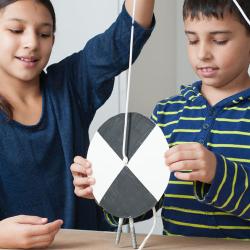Source Institutions
Source Institutions
Add to list Go to activity
Activity link broken? See if it's at the internet archive

How do scientists measure how clear or murky water in a lake is? How does water clarity (clearness) affect what lives in the lake? In this outdoor activity, learners will make their own Secchi disk to measure the clarity of a body of water, and will test it outside in their own community. Learners can even enter the data they gather in an online database to help scientists monitor the health of lakes and streams. Step-by-step instructions are included with photos along with safety recommendations. Activity guide includes a "What's going on?" explanation and relevant connections to the role of sunlight in lake ecosystems.
- 10 to 30 minutes
- 10 to 30 minutes
- $10 - $20 per group of students
- Ages 8 - adult
- Activity, Experiment/Lab Activity
- English
Quick Guide
Materials List (per group of students)
- 3 disposable plastic dinner plates, at least 20 cm in diameter (black or white is best)
- Thick, light-colored string that won’t stretch, such as nylon, at least 10 m long
- Weights such as nuts or metal washers with holes large enough to pull the string through
- White and black waterproof paint
- Paintbrush
- Scissors (strong enough to cut plastic plates)
- Stapler or strong glue
- Masking tape
- Tape measure
- Hammer and nail
- Dark marker
- Ruler or other straight edge (such as a book)
- Recording device (notebook and pen/pencil or mobile device)
- Access to a body of water, at a location where you can’t see to the bottom
- 3 disposable plastic dinner plates, at least 20 cm in diameter (black or white is best)
- Thick, light-colored string that won’t stretch, such as nylon, at least 10 m long
- Weights such as nuts or metal washers with holes large enough to pull the string through
- White and black waterproof paint
- Paintbrush
- Scissors (strong enough to cut plastic plates)
- Stapler or strong glue
- Masking tape
- Tape measure
- Hammer and nail
- Dark marker
- Ruler or other straight edge (such as a book)
- Recording device (notebook and pen/pencil or mobile device)
- Access to a body of water, at a location where you can’t see to the bottom
Subjects
-
Earth and Space Science
-
Earth Structure
- Oceans and Water
-
Earth Structure
-
Life Sciences
-
Ecology
- Ecosystems
- Human Impact
-
Ecology
-
Mathematics
-
Data Analysis and Probability
- Data Collection
-
Data Analysis and Probability
Informal Categories
- Citizen Science
- Nature and Environment
- Outdoor Activity
Audience
To use this activity, learners need to:
- see
Learning styles supported:
- Uses STEM to solve real-world problems
- Involves hands-on or lab activities
Other
Components that are part of this resource:
This resource is part of:
Access Rights:
- Free access
By:
Source Collection
- DIY Science Apps
Rights:
- , The Regents of the University of California, 2015
Funding Source:
- National Science Foundation, DRL1114663
